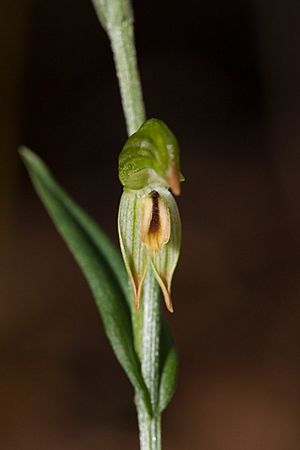Montane leafy greenhood facts for kids
Quick facts for kids Montane leafy greenhood |
|
|---|---|
 |
|
| Pterostylis jonesii growing near the Cotter River | |
| Scientific classification | |
| Genus: |
Pterostylis
|
| Species: |
jonesii
|
| Synonyms | |
|
Bunochilus montanus D.L.Jones |
|
The Pterostylis jonesii, often called the montane leafy greenhood, is a special type of orchid plant. It belongs to the orchid family, known for its beautiful and unique flowers. This plant is only found in a small part of south-eastern Australia, meaning it's endemic to that area.
Each montane leafy greenhood plant can look different depending on its stage. Some plants have a group of three to six leaves that grow in a circle, like a rosette. Other plants have a tall stem with flowers, called a flowering spike. This spike can have up to eleven flowers and five to seven leaves along its stem. The flowers are a see-through green color with faint darker green lines. They also have a brownish-yellow lip, called a labellum, with a dark stripe down the middle.
What Does the Montane Leafy Greenhood Look Like?
The montane leafy greenhood is a plant that grows from an underground part, like a small potato, called a tuber. It's a perennial plant, meaning it lives for more than two years, and it's deciduous, so it loses its leaves at certain times.
- Leaves: Plants that are not flowering have a rosette of leaves. These leaves are narrow and egg-shaped, about 6 to 25 millimeters (0.2 to 1 inch) long and 2 to 6 millimeters (0.08 to 0.2 inches) wide.
- Flowering Spike: When the plant flowers, it sends up a tall spike that can be anywhere from 150 to 700 millimeters (6 to 27 inches) high. This spike has between five and seven leaves on its stem, which are 10 to 70 millimeters (0.4 to 2.7 inches) long and 3 to 5 millimeters (0.1 to 0.2 inches) wide.
- Flowers: The flowers themselves are about 13 to 16 millimeters (0.5 to 0.6 inches) long. The top part of the flower, made of the sepal and petals, forms a hood over the center. The lower parts, called lateral sepals, point downwards. They are 12 to 15 millimeters (0.5 to 0.6 inches) long and 6 to 8 millimeters (0.2 to 0.3 inches) wide. These lower parts are joined together for about half their length and then end in orange-brown tips.
- Labellum: The labellum, or lip, of the flower is about 6 millimeters (0.2 inches) long and 2 millimeters (0.08 inches) wide. It's brownish-yellow and covered with tiny hair-like cells. A dark stripe runs along its middle.
- Flowering Time: You can see these orchids flowering from August to November.
How This Orchid Got Its Name
This greenhood orchid was first officially described in 2006 by a botanist named David Jones. He gave it the name Bunochilus montanus.
However, in 2007, another botanist, Gary Backhouse, changed its name to Pterostylis jonesii. He did this because the name Pterostylis montana was already being used for a different orchid found in New Zealand. The new name, jonesii, was chosen to honor David Jones, who first described the plant.
Where the Montane Leafy Greenhood Lives
The montane leafy greenhood is only found in certain forests. These forests are located in the higher parts of north-eastern Victoria and southern New South Wales in Australia.

